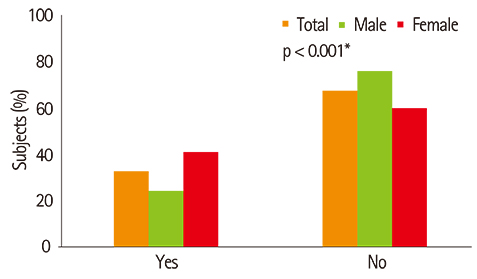Clin Nutr Res.
2014 Jan;3(1):24-32. 10.7762/cnr.2014.3.1.24.
Energy Content Estimation by Collegians for Portion Standardized Foods Frequently Consumed in Korea
- Affiliations
-
- 1Department of Food and Nutrition, Kangwon National University, Samcheok 245-711, Korea.
- 2Nutrition Safety Policy Division, Food Nutrition and Dietary Safety Bureau, Ministry of Food and Drug Safety, Cheongwon 363-700, Korea.
- 3Division of Food Science, Kongju National University, Yesan 340-742, Korea.
- 4Department of Food and Nutrition, Korea National University of Transportation, Jeungpyung 368-701, Korea. mhkim1129@ut.ac.kr
- KMID: 2279618
- DOI: http://doi.org/10.7762/cnr.2014.3.1.24
Abstract
- The purpose of this study is to estimate Korean collegians' knowledge of energy content in the standard portion size of foods frequently consumed in Korea and to investigate the differences in knowledge between gender groups. A total of 600 collegians participated in this study. Participants' knowledge was assessed based on their estimation on the energy content of 30 selected food items with their actual-size photo images. Standard portion size of food was based on 2010 Korean Dietary Reference Intakes, and the percentage of participants who accurately estimated (that is, within 20% of the true value) the energy content of the standard portion size was calculated for each food item. The food for which the most participants provided the accurate estimation was ramyun (instant noodles) (67.7%), followed by cooked rice (57.8%). The proportion of students who overestimated the energy content was highest for vegetables (68.8%) and beverages (68.1%). The proportion of students who underestimated the energy content was highest for grains and starches (42.0%) and fruits (37.1%). Female students were more likely to check energy content of foods that they consumed than male students. From these results, it was concluded that the knowledge on food energy content was poor among collegians, with some gender difference. Therefore, in the future, nutrition education programs should give greater attention to improving knowledge on calorie content and to helping them apply this knowledge in order to develop effective dietary plans.
MeSH Terms
Figure
Reference
-
1. Choi MK, Kim MH. A study on recognition of food calories of college students in Chungnam. J Korean Soc Food Sci Nutr. 2002; 31:696–702.
Article2. Hwang JH, Lee HM. A study on lifestyles, dietary habits, nutrition knowledge and dietary behaviors of male university Students according to residence type. Korean J Community Nutr. 2007; 12:381–395.3. Hong MS, Park HO, Sohn CY. A study on food behaviors and nutrient intakes according to body mass index and body image recognition in female university students from Incheon. Korean J Food Nutr. 2011; 24:386–395.
Article4. Gray C, Lytle LA, Mays R, Taylor G, Perry C, Story M. Foods on students' trays when they leave the cafeteria line as a proxy for foods eaten at lunch in a school-based study. J Am Diet Assoc. 2002; 102:407–409.
Article5. Ko SY, Kim KW. Nutrition label use, self-efficacy, snacking and eating behavior of middle school students in Kyunggi area. Korean J Community Nutr. 2010; 15:513–524.6. Kim G, Lee JW. Development and evaluation of CAI program on food guide pagoda for adolescents. Chungnam J Hum Ecol. 2006; 19:83–98.7. The Korean Nutrition Society. Dietary reference intakes for Koreans 2010. Seoul: The Korean Nutrition Society;2010.8. Ministry of Health and Welfare, Korea Centers for Disease Control and Prevention. Korea Health Statistics 2010: Korea National Health and Nutrition Examination Survey (KNHANES V-1). Cheongwon: Korea Centers for Disease Control and Prevention;2011.9. del Balzo V, Scanu A, Dernini S, Palmieri O, Cannella C. Mediterranean lifestyle: nutritional education on-line. Ann Ig. 2009; 21:565–573.10. Choi MK, Ko MJ, Kim MH. Adolescents' estimation of energy content of standard portion size of foods and its association with body mass index. Food Nutr Sci. 2012; 3:1340–1348.
Article11. Ministry of Health and Welfare, Korea Centers for Disease Control and Prevention. Korea Health Statistics 2011: Korea National Health and Nutrition Examination Survey (KNHANES V-2). Cheongwon: Korea Centers for Disease Control and Prevention;2012.12. Kim MH, Kim H, Kim WK, Kim SJ, Yeon JY. Food habits and dietary behavior related to using processed food among male college students residing in dormitory and self-boarding in Gangwon. Korean J Community Nutr. 2013; 18:372–385.
Article13. Turrell G. Determinants of gender differences in dietary behavior. Nutr Res. 1997; 17:1105–1120.
Article14. Parmenter K, Waller J, Wardle J. Demographic variation in nutrition knowledge in England. Health Educ Res. 2000; 15:163–174.
Article15. Oakes ME, Slotterback CS. Gender differences in perceptions of the healthiness of foods. Psychol Health. 2001; 16:57–65.
Article16. Lee D, Lee JC, Kim MH. Effect of menu calorie labels on menu sales and consumer's recognition at a Korean restaurant in a hotel. Korean J Community Nutr. 2013; 18:505–514.
Article17. Roberto CA, Larsen PD, Agnew H, Baik J, Brownell KD. Evaluating the impact of menu labeling on food choices and intake. Am J Public Health. 2010; 100:312–318.
Article18. Tandon PS, Wright J, Zhou C, Rogers CB, Christakis DA. Nutrition menu labeling may lead to lower-calorie restaurant meal choices for children. Pediatrics. 2010; 125:244–248.
Article19. Dumanovsky T, Huang CY, Nonas CA, Matte TD, Bassett MT, Silver LD. Changes in energy content of lunchtime purchases from fast food restaurants after introduction of calorie labelling: cross sectional customer surveys. BMJ. 2011; 343:d4464.
Article
- Full Text Links
- Actions
-
Cited
- CITED
-
- Close
- Share
- Similar articles
-
- Preliminary Study on the Establishment of Proper Portion Using Consumed Size and Food Preference of Frequently Served Meals in the Elementary School Lunch Program in Inchon - 2 . A Study on the Consumption Size of Frequently Served Meals in the Elementary School Lunch Program in Inchon
- Estimation of curcumin intake in Korea based on the Korea National Health and Nutrition Examination Survey (2008-2012)
- Portion sizes of foods frequently consumed by the Korean elderly: Data from KNHANES IV-2
- The Relationship between High Energy/Low Nutrient Food Consumption and Obesity among Korean Children and Adolescents
- Comparison of sodium content of workplace and homemade meals through chemical analysis and salinity measurements



